How many appealing vehicles can you name that were only sold for one year?
Even the Edsel lasted three.
Here’s one that came – and went – as fast as it went: the 1991 GMC Syclone.
Zero to 60 in 4.3 seconds.
Tat was back in ’91 – when a new L98 (Tuned Port Injection) Corvette took 5.3 seconds to make the same run. A Camry V6 does the same today. Even the exotic ZR1 Corvette, with its DOHC V8, needed 4.4. seconds to do what the Syclone did quicker.
Nothing American could touch the Syclone in a straight-up drag race – and few things foreign (including Ferraris) could match it, either. Car and Driver magazine famously road-tested one against a then-new $122,000 Ferraris 348ts.
The truck won.
Despite costing about $100k less than the Ferrari.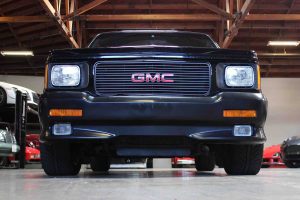
It wouldn’t be until 2002 that GM built something quicker than the Syclone. And that car – the ’02 Z06 Corvette – was just barely quicker (0-60 in 4.2 seconds).
So, how come this phenomenal performer was such a brief blip on the radar?
Well, for openers, it was a truck.
A small truck.
And – let’s be blunt – a cheap truck.
Well, the truck it was based on was. And it’s hard to turn Motel 6 into the Ritz – no matter how nicely you dress up the individual rooms.
The Syclone was, when all is said and done, a hopped-up GMC Jimmy. And the Jimmy was the GMC-badged version of the lowly Chevy S-10. Which was the successor to the even lowlier Chevy Luv.
The Syclone, then, was the truck-equivalent of a really quick Pinto.
Not that there’s anything wrong with that.
But people – most people – will take (and pay for) the slower Corvette.
Early models of this utilitarian pick-up were powered (if you want to call it that) by sump pump fours that struggled to develop double-digit output (82 hp from 1.9 liters, rocked up to 94 hp from 2.5 liters by 1990). The top gun (pop gun?) Jimmy option was a 2.8 liter, 125 hp V6.
Suffice to say, it was an unlikely platform for a performance truck. And probably a really bad idea for a successful (sales-wise) performance truck.
Except in one respect.
It was light.
The ’91 S-10 that served as the donormobile for what became the Syclone had a curb weight of about 3,300 lbs. As it turns out, this is virtually the same curb weight as a 1991 L98 Corvette. And much lighter than a full-size truck such as a ’91 C/K 1500 – which weighed about 1,000 pounds more.
The first rule of going fast is to weigh less than the other guy.
So going with the Jimmy as the starting point for a serious sleeper – a turbocharged, all-wheel-drive Saturday Night Special – was sheer brilliance, if the object of the exercise was to not just bitch-slap known performance cars like the Car & Driver Ferrari 348, but to do it to them before the saw it coming. The Syclone was like a Pinto with a Boss 429 crammed under its hood.
Who’d a thunk it?
Who’d a suspected it?
C&D writer Pat Bedard described the deliciousness of leaving the six-figure Ferrari flat-footed when the light went green. Of glancing in the Syclone’s rearview as the Italian supercar struggled to catch up to his breathed-on Jimmy:
“When the truck’s brakes come off, full boost is downloaded to all four wheels. They barely slip. Acceleration begins with such a jolt the driver feels his breakfast slosh rearward. In a blink, the Ferrari is looking at tailgate. And the tailgate is getting smaller. Half a car length, one, two-car lengths of daylight between them before the Ferrari tops out of first gear. The race has just begun and already looks like a massacre.”
An Iron Sheik-esque humbling, actually. A vehicular Camel Clutch – and so much worse.
For the victim.
Being a truck had another advantage – if the object of the exercise is to whizz one by Uncle. Back in the ’90s, the Federal government’s fuel efficiency, saaaaaaafety and emissions requirements differed for passenger cars and what were then categorized as “light trucks,” the category into which the utilitarian little Jimmy fell.
Things that would cause problems – or never pass muster – if applied to a Corvette slid under the radar when applied to something like the Jimmy.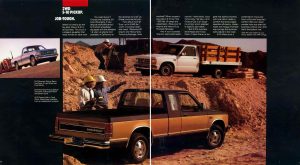
Also, the Jimmy was really cheap to make.
Nothing fancy about it, fundamentally. This was obvious once you sat behind the wheel and gazed upon the sheets of extruded plastic and shared-with-$10k-Jimmys knobs and switches. No fiberglass to mold, just bolt on some flares and splash it all with evil-looking shiny black paint.
The potential profit margin per truck was thus a lot more favorable, even for a specialty sub-model like the Syclone.
Assuming, of course, people recognized its magnificence.
Only a few did, as it turned out.
More should have. This truck was one for the record books, leaving four-wheeled ripples across the cover of said book.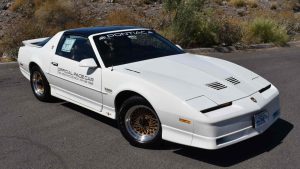
Technically, GM did not build the Syclone. They were built for GMC by a contractor – Production Automotive Services, based in Troy, Michigan. They had previously been tasked by Pontiac with making the 1989 20th Anniversary Trans-Am something special.
They succeeded.
The first – and only – six-cylinder Trans-Am created by PAS turned out to be the quickest and fastest Trans-Am ever. Quicker, even, than the ’73-’74 SD-455 Trans-Am. Faster – by far – than any prior Trans-Am. These things ran high 12s in the quarter and topped out somewhere to the right of 150 MPH.
Turbocharging and intercooling the six was the key to it all – and the same formula would be applied to what became the Syclone (and subsequently, its also-short-lived successor, the ’92-’93 GMC Typhoon). 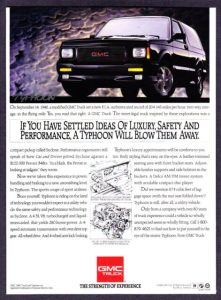
The heart of the package was a turbo’d version of Chevy’s 4.3 liter “small block” V6 (a departure from the Buick-sourced 3.8 liter V6 used in the 20th Anniversary TA).
This engine was based on the venerable line of 90 degree small block Chevy V8s dating back to the 1955 283 and subsequent 327 and 350 V8s, but with six rather than eight cylinders. The same basic engine had become optional in the Jimmy and S-10 but this one was very special.
It featured a heavy-duty cast iron bock with reinforced main caps, special (dished) pistons, high capacity fuel injectors, and a Garrett intercooler feeding chilled air to a Mitsubishi-sourced turbocharger stuffing the mix into the six at 14 psi under full boost. The end result – so said GMC – was 280 hp and 350 ft.-lbs. of torque.
This was at least 35 more hp (and 5 ft.-lbs. more torque) than the same-year Corvette’s L98 Tuned Port Injection 350 (5.7 liter) V8 delivered.
And that was only what was admitted to.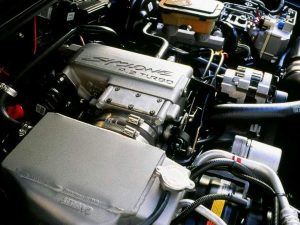
Road tests strongly indicated something fishy – in a good way. The “280 hp” Syclone delivered a juggernaut of acceleration that made the L98 (and even the ZR-1) Corvette seem dowdy in comparison. It was easily 1 full second speedier to 60 – and a 35 hp difference doesn’t explain that, Lucy.
Just as the ’89 Turbo Trans-Am was much stronger than its advertised 280 hp rating, so also the Syclone’s output was probably under-rated by at least 20 percent.
Both of these ringers were probably making closer to 350 horsepower. Keep in mind the Syclone’s not-so-hot aerodynamics (which limited its top speed; one of its few weaknesses as a performance ride) and the fact that while the standard AWD system helped to hook it up, it also increased the truck’s weight. The modified four-speed automatic (no manual was available) did help the boosted six wick up quickly via a high-stall torque converter – this works kind of like bringing up the revs prior to side-stepping the clutch in a manual-equipped car – and also multiplies the available torque, which a turbo engine makes lots of. But one must also take into consideration the slippage losses through the converter – at least in this days, when automatics were much less efficient at transferring power than they are today, almost 40 years down the road.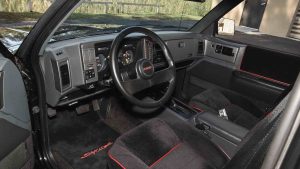
The Corvette was easier to get moving – and its much superior aerodynamics ought to have enabled it to move faster.
But the fact was, it didn’t – at least, not until you reached triple digit speeds – at which point the Corvette (and the C&D Ferrari 348) finally began to pull away. The Syclone’s top speed was just under 130 MPH, whether drag limited (likely) or electronically (for liability reasons). A ZR-1 was just getting rolling at 130.
The Ferrari, too.
Still, there was something fabulous – and appalling, if you owned the Ferrari – about a hopped-up GMC Jimmy that could walk away from you in a straight-up stoplight to stoplight street race.
And that may be just what killed it off.
It was too fast – and too cheap – to live.
Car people know that within GM corporate there has long been an unspoken but cruelly enforced policy – a third rail of sorts – that engineers dare not transgress. It is that Corvette must always be the highest-performing vehicle GM sells.
Period.
A knacker’s fate awaits those who test this policy – examples including the fate of John DeLorean’s XP-833 Banshee prototype, which got pulled at the very last minute from the 1965 New York Auto Show when GM higher-ups caught wind of it. The two-seater gullwing coupe – which would have been sold through Pontiac – was too close for comfort to what eventually came out (via Chevrolet) as the ’68 Corvette.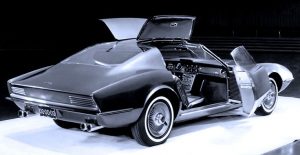
Another deader was the previously mentioned ’89 Turbo Trans-Am. It was too quick – and much too fast – for its own good. It had embarrassed the ’89 Corvette – and that would not do.
Note that the turbo TA was only made once, too.
Very possibly, the ax fell on the Syclone’s neck for exactly the same reason. Bad enough that a Trans-Am dared to outperform the Corvette.
But a Jimmy?
Weirdness entered into the bargain, too.
In 1991, all-wheel-drive was not only exotic, it was foreign. Audis, sure. But Chevys and GMCs?
A GMC truck?
What are you supposed to do with all-wheel-drive? It’s not for towing – but then, what good is a truck that can’t pull? Yes, yes, it hauls. But then why carry around that useless bed? GMC affixed a sticker that warned buyers not to put more than 500 pounds back there, else risk “damage to drivetrain and suspension.” This was the necessary compromise that attended dropping the thing’s ride height down several inches from the standard Jimmy’s – which pretty much eliminated the suspension travel that’s designed into most trucks.
So that they can carry stuff.
The Syclone could only carry two people.
It didn’t even have back seats. 
Today, of course, all-wheel-drive is as common as carburetors still were back in the early ’90s. But 25 years ago, it was new – and slightly strange. People who bought Audis grokked it.
People who bought GMCs and Chevys did not.
Another bit of tech the Syclone featured was four-wheel anti-lock brakes, the first production application of this now ubiquitous technology. But early ABS systems – like early AWD systems – had some operating characteristics that took some getting used to. Such as feedback – pulsation – that could be felt through the brake pedal as the system did the electronic equivalent of pumping the brakes.
Still, for those in the know – and those who got out their checkbooks in time – the Syclone was a ride not to be missed.
Not quite 3,000 of these unlikely contenders made it to daylight – and all of those remaining today are as collectible as China plates with the White Star loggia recovered from the ocean floor.
Syclone Stuff:
*Despite having a truck-style solid-axle (non-independent) rear suspension, the Syclone was capable of achieving lateral skid pad numbers very close to those of the same-year Corvette. And despite having drum brakes out back, it took less distance to stop a Syclone than a same-year Ferrari 348.
* At least a handful of Syclones were exported to Saudi Arabia, land of leaded premium fuel. The catalytic converter (mandatory in the United States since 1975) was thrown in the woods and replaced with a “resonator.” The ECU was also reprogrammed for leaded high-test. Given the lowered backpressure – and higher octane fuel – these Syclones were probably the quickest and fastest of the lot.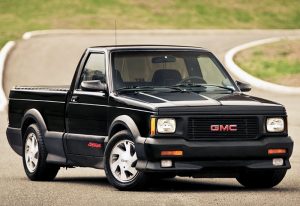
* The all-wheel-drive system (made by Borg Warner) split torque in a fixed 35-65 ratio, with 35 percent routed to the front wheels and 65 percent to the rear. Unlike modern AWD systems, the Syclone’s AWD system could not modulate power delivery in varying ratios either front to rear or from individual wheel to wheel, as most modern AWD systems can.
* In addition to the turbocharged V6 and AWD system, all Syclones were fitted with special 16×8 wheels and low-profile (50-series) Firestone Firehawk SVX tires, fast-ratio steering and a special gauge package (borrowed from the 1990 Pontiac Sunfire turbo). All 1991 Syclones were painted black – though other colors had been planned for the second-year production run that never happened.
* The rarest of all Syclones are the ten modified by American Sunroof Corporation, with styling input from auto industry legend Larry Shinoda (who among other things helped design both the ’63 Stingray Corvette while at GM and then – when he jumped ship and worked for Ford – the 1970 Boss 302 Mustang). All ten trucks were repainted red and featured targa roofs, a matching red fiberglass tonneau cover for the bed, Recaro sport buckets, a high-end Sony system, Borla exhaust system and reprogrammed ECU.
. . .
If you like what you’ve found here please consider supporting EPautos.
We depend on you to keep the wheels turning!
Our donate button is here.
If you prefer not to use PayPal, our mailing address is:
EPautos
721 Hummingbird Lane SE
Copper Hill, VA 24079
PS: Get an EPautos magnet or sticker or coaster in return for a $20 or more one-time donation or a $10 or more monthly recurring donation. (Please be sure to tell us you want a magnet or sticker or coaster – and also, provide an address, so we know where to mail the thing!)
If you like items like the Keeeeeeeeev! t shirt pictured below, you can find that and more at the EPautos store!



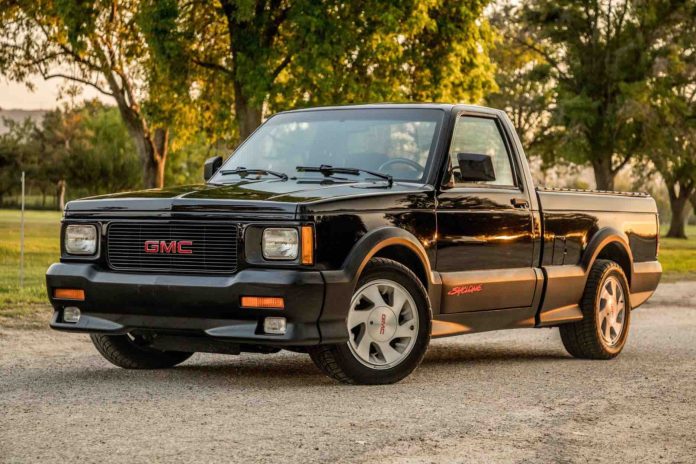







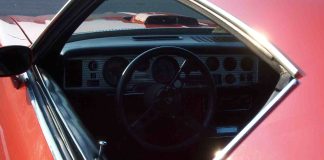
The don’t be better than the Vette rule needs to die. These other vehicles cost GM not one Corvette sale. If anything it costs them sales to competitors, by not besting the Vette so people look elsewhere.
Someone local to me, at least at some point in the past, owned one of the ten American Sunroof Corporation Syclones. He would sometimes bring it to car shows. I knew it was rare, but didn’t realize there were only ten of them. Haven’t seen it in a long time, so guessing it got sold and isn’t local anymore.
It does very well in the auction markets. Cool car.
I believe (maybe Eric can clarify) that there was a period in the 1970’s that the Chevy Surburban was the fastest US production vehicle because at the time it dodged all the anti-pollution junk required on cars. Wild to think that a plain truck can be so much faster than “hot rods” due to the government rules.
I owned a 1977 Mustang (labeled a Cobra) with a really sharp “paint-on” package. It looked like a rocket but ran like a dog. The 302 in it was a shadow of the original version.
I don’t know about the Suburbans, but it was true for the Little Red Express Dodge stepsides with the 360s in them.
So… There’s a Syclone conversion kit for my ’94 S-10, right? I could leave the suspension as is, though the AWD might help out in the mud. I could enjoy smoking a ‘vette or your average pesky police cruiser…
Hi BaDnOn,
Those Jimmys were really light; even a mild V6 could make them jump and if the 4.3 was a bolt-in/factory item than my guess is a small block V8 would go right in with not much work (maybe ball-peen the firewall a bit). That would be almost as much fun as pushing past a Face Diaper dispenser!
Hey Eric,
It might happen some day. Right now, that old 2.2L is still purring sweetly. But when it’s finally time, maybe an aluminum block 350 would do nicely. >:) (Man has to dream…)
A 2.2L? I think that’s what my ’91 had. It was ok, but that 4.3 sure was a better pedal to the metal.
Ooo, I had a ’94 S-10, too. It was a great suv! I liked it just about as much as my ~(?) ’91 S-10 with TBI. ‘Cause the Vortex, when it went out, wasn’t cheap to fix.
Anyway, in the early ’90’s I saw under the hood of an S-10, dunno the year, the guys had put in a v-8. The problem they were having was the fan bumping into the radiator ever-so-slightly.
…Not as many aftermarket options back then, I guess?
Perhaps a little bending and shaving on that fan? And no, there don’t seem to be a lot of opportunities, even today, to hotrod that year of S-10.
RE: “And no, there don’t seem to be a lot of opportunities, even today, to hotrod that year of S-10.”
That’s really surprising. I’d a thought there’d be tons. …Esp with all the 3-D printers out there.
…Who knows, when we get to be more Cuba-like, there will be? Idk.
I liked & miss my S-10’s, they could follow the Jeeps…. It sucks, rust, never sleeps.
As I recall, you’re in a road-salt free zone.
…That must be nice. …That part, anyway.
I’ve had a few V8 swapped S10s. Flex fan or electric (no room for a fan clutch) and depending on the distributor/motor mounts used you might need to massage the firewall a bit (watch out for the wiper mechanism…). Plenty of exhaust options.
Easy swap IMO but the biggest weak point is the 7.5″ rear, doesn’t take much to grenade one.
My ’82 2wd with cast iron V8 and 9″ rear only weighed 3165 pounds with me in it.
Good stuff, Bob!
I sometimes think about putting a GM 3.8 V6 in my little Nissan pick-up, so it could pull more. But the damn thing runs so well I can’t bring myself to do it…
I’ve had similar thoughts with mine (’99 frontier). 3.8 & 5 sp from a 2000s camaro would make a nice upgrade from the parapalegic hamster ka24de.
Currently trying to sort out a drivability issue with mine that makes this even more tempting just not budget friendly…
Hi DB,
Yup! I love my little ’02 Frontier; it’s slow and guzzles gas – but it’s been extremely reliable and almost entirely problem free for as long as I’ve owned it, which is going on 15 years now.
I work at the gm PG. Something under foot around 86-87 ish was the installation of the Quad 4 motor into the Fiero GT chassis. From what I was told at the time was the mounting bolt pattern to the trans was identical to v6 that came with that car, I also was told it blew the Vette’s ass in acceleration AND cornering in the all important (at that time anyways) G circle tests. It too fell victim to the Corvette “rule”
It was the Syclone that spawned a bevy of high performance super-trucks: the 1993 Ford F150 Lightning (the REAL one with the 5.8 liter engine from the Cobra R—NOT THE EV!) and SVT Lightning, the Chevy 454 SS (which was made around the same time for folks who like their trucks bigger), and the Dodge Ram SRT10 with the Viper engine and Durango Hellcat.
Ford and Chrysler also didn’t seem to have such arrangements whereby no other vehicles could be faster than their halo cars (Mustang GT/Cobra, Viper), so they had a bit more latitude with their super trucks. In fact, they advertised their super-trucks as credible alternatives and additions to their Mustangs, Cobras, and Vipers. In other words, you can get performance and practicality in terms of passenger and cargo space. I remember an ad for an SRT10 calling it “a Viper that hauls in more ways than one.”
I also recall that Carroll Shelby had arrangements with both Ford and Dodge to build some of their super-trucks.
Today, all of that is gone in favor of “The Cybertruck…”
wow – this thing makes it seem so easy to be so fast…. no need for all the crap we have on cars today !
Tony Angelo is building a Syclone clone.
https://m.youtube.com/playlist?list=PLVOdPLzbmDUaFCiAATTFr9CwphG2mE6_m
Thanks for this reminder. One day we will build great things again. Unfortunately we must suffer for a while longer so idiots can get back to living instead of virtue-signaling.